基于多谱的多模态深度学习方法用于肺癌早期诊断
IF 4.6
2区 化学
Q1 SPECTROSCOPY
Spectrochimica Acta Part A: Molecular and Biomolecular Spectroscopy
Pub Date : 2025-09-12
DOI:10.1016/j.saa.2025.126932
引用次数: 0
摘要
肺癌仍然是世界上最致命的恶性肿瘤之一,早期和准确的诊断至关重要。传统的诊断技术,如成像和组织病理学,经常受到成本高、辐射暴露和依赖专家经验等限制。本研究提出了一种基于多光谱的肺癌检测多模态深度学习方法。该方法将傅里叶变换红外光谱、紫外-可见吸收光谱、荧光光谱和拉曼光谱四种常用光谱集成到一个统一的检测框架中。具体来说,每个光谱样本都由其一维(1D)序列和二维(2D)格拉曼角求和场(GASF)图像表示。双分支架构设计用于捕获1D模式和2D特征。这些互补的特性通过基于mambavision的融合模块进行融合,以实现高效的跨模态交互和全局上下文建模。该方法的准确率为97.65%,精密度为98.14%,召回率为97.52%,f1分数为97.82%,AUC为99.76%。通过对比和烧蚀实验,验证了训练策略和方法的优越性。基于T-SNE和类别激活映射的可解释性分析证明,该模型在检测过程中关注有意义的光谱区域。这项工作为基于光谱的智能诊断展示了一个有前途的范例。本文章由计算机程序翻译,如有差异,请以英文原文为准。

Multimodal deep learning method based on multiple spectra for lung cancer early diagnosis
Lung cancer remains one of the most lethal malignancies worldwide, and the early and accurate diagnostic is critical. Traditional diagnostic techniques such as imaging and histopathology often suffer from limitations including high cost, radiation exposure, and reliance on expert experience. In this study, a multimodal deep learning method based on multiple spectra is proposed for lung cancer detection. The method integrates four common spectra including Fourier transform infrared spectra, UV–vis absorbance spectra, fluorescence spectra, and Raman spectra into a unified detection framework. Specifically, every spectrum sample is represented by its one-dimensional (1D) sequence and two-dimensional (2D) Gramian Angular Summation Field (GASF) image. A dual-branch architecture was designed to capture 1D patterns and 2D features. These complementary features are fused through a MambaVision-based fusion module to achieve efficient cross-modal interaction and global context modeling. The proposed method achieved outstanding performance with accuracy of 97.65 %, precision of 98.14 %, recall of 97.52 %, F1-score of 97.82 %, and AUC of 99.76 %. Moreover, the comparison and ablation experiments confirm the superiority of the training strategy and the proposed method. Interpretability analysis based on T-SNE and Class Activation Mapping proves that the model focuses on meaningful spectral regions in the detection process. This work demonstrates a promising paradigm for spectral-based intelligent diagnosis.
求助全文
通过发布文献求助,成功后即可免费获取论文全文。
去求助
来源期刊
CiteScore
8.40
自引率
11.40%
发文量
1364
审稿时长
40 days
期刊介绍:
Spectrochimica Acta, Part A: Molecular and Biomolecular Spectroscopy (SAA) is an interdisciplinary journal which spans from basic to applied aspects of optical spectroscopy in chemistry, medicine, biology, and materials science.
The journal publishes original scientific papers that feature high-quality spectroscopic data and analysis. From the broad range of optical spectroscopies, the emphasis is on electronic, vibrational or rotational spectra of molecules, rather than on spectroscopy based on magnetic moments.
Criteria for publication in SAA are novelty, uniqueness, and outstanding quality. Routine applications of spectroscopic techniques and computational methods are not appropriate.
Topics of particular interest of Spectrochimica Acta Part A include, but are not limited to:
Spectroscopy and dynamics of bioanalytical, biomedical, environmental, and atmospheric sciences,
Novel experimental techniques or instrumentation for molecular spectroscopy,
Novel theoretical and computational methods,
Novel applications in photochemistry and photobiology,
Novel interpretational approaches as well as advances in data analysis based on electronic or vibrational spectroscopy.

 求助内容:
求助内容: 应助结果提醒方式:
应助结果提醒方式:


